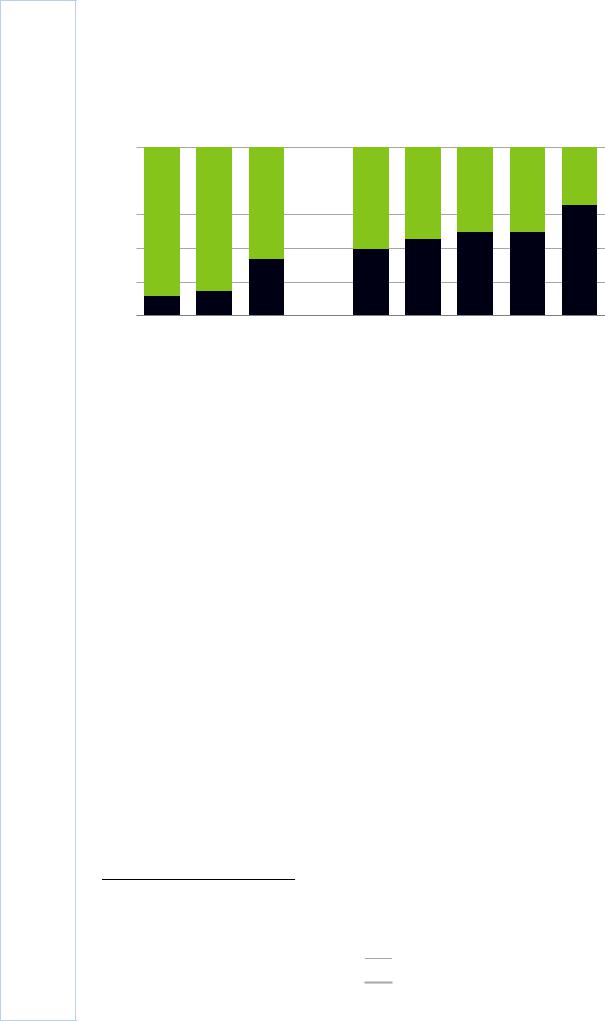
- •Foreword
- •Table of contents
- •Figures
- •Tables
- •Boxes
- •1. Executive summary
- •Energy system transformation
- •Special focus 1: The cost-effectiveness of climate measures
- •Special focus 2: The Electricity Market Reform
- •Special focus 3: Maintaining energy security
- •Key recommendations
- •2. General energy policy
- •Country overview
- •Institutions
- •Supply and demand trends
- •Primary energy supply
- •Energy production
- •Energy consumption
- •Energy policy framework
- •Energy and climate taxes and levies
- •Assessment
- •Recommendations
- •3. Energy and climate change
- •Overview
- •Emissions
- •GHG emissions
- •Projections
- •Institutions
- •Climate change mitigation
- •Emissions targets
- •Clean Growth Strategy
- •The EU Emissions Trading System
- •Low-carbon electricity support schemes
- •Climate Change Levy
- •Coal phase-out
- •Energy efficiency
- •Low-carbon technologies
- •Adaptation to climate change
- •Legal and institutional framework
- •Evaluation of impacts and risks
- •Response measures
- •Assessment
- •Recommendations
- •4. Renewable energy
- •Overview
- •Supply and demand
- •Renewable energy in the TPES
- •Electricity from renewable energy
- •Heat from renewable energy
- •Institutions
- •Policies and measures
- •Targets and objectives
- •Electricity from renewable energy sources
- •Heat from renewable energy
- •Renewable Heat Incentive
- •Renewable energy in transport
- •Assessment
- •Electricity
- •Transport
- •Heat
- •Recommendations
- •5. Energy efficiency
- •Overview
- •Total final energy consumption
- •Energy intensity
- •Overall energy efficiency progress
- •Institutional framework
- •Energy efficiency data and monitoring
- •Regulatory framework
- •Energy Efficiency Directive
- •Other EU directives
- •Energy consumption trends, efficiency, and policies
- •Residential and commercial
- •Buildings
- •Heat
- •Transport
- •Industry
- •Assessment
- •Appliances
- •Buildings and heat
- •Transport
- •Industry and business
- •Public sector
- •Recommendations
- •6. Nuclear
- •Overview
- •New nuclear construction and power market reform
- •UK membership in Euratom and Brexit
- •Waste management and decommissioning
- •Research and development
- •Assessment
- •Recommendations
- •7. Energy technology research, development and demonstration
- •Overview
- •Energy research and development strategy and priorities
- •Institutions
- •Funding on energy
- •Public spending
- •Energy RD&D programmes
- •Private funding and green finance
- •Monitoring and evaluation
- •International collaboration
- •International energy innovation funding
- •Assessment
- •Recommendations
- •8. Electricity
- •Overview
- •Supply and demand
- •Electricity supply and generation
- •Electricity imports
- •Electricity consumption
- •Institutional and regulatory framework
- •Wholesale market design
- •Network regulation
- •Towards a low-carbon electricity sector
- •Carbon price floor
- •Contracts for difference
- •Emissions performance standards
- •A power market for business and consumers
- •Electricity retail market performance
- •Smart grids and meters
- •Supplier switching
- •Consumer engagement and vulnerable consumers
- •Demand response (wholesale and retail)
- •Security of electricity supply
- •Legal framework and institutions
- •Network adequacy
- •Generation adequacy
- •The GB capacity market
- •Short-term electricity security
- •Emergency response reserves
- •Flexibility of the power system
- •Assessment
- •Wholesale electricity markets and decarbonisation
- •Retail electricity markets for consumers and business
- •The transition towards a smart and flexible power system
- •Recommendations
- •Overview
- •Supply and demand
- •Production, import, and export
- •Oil consumption
- •Retail market and prices
- •Infrastructure
- •Refining
- •Pipelines
- •Ports
- •Storage capacity
- •Oil security
- •Stockholding regime
- •Demand restraint
- •Assessment
- •Oil upstream
- •Oil downstream
- •Recommendations
- •10. Natural gas
- •Overview
- •Supply and demand
- •Domestic gas production
- •Natural gas imports and exports
- •Largest gas consumption in heat and power sector
- •Natural gas infrastructure
- •Cross-border connection and gas pipelines
- •Gas storage
- •Liquefied natural gas
- •Policy framework and markets
- •Gas regulation
- •Wholesale gas market
- •Retail gas market
- •Security of gas supply
- •Legal framework
- •Adequacy of gas supply and demand
- •Short-term security and emergency response
- •Supply-side measures
- •Demand-side measures
- •Gas quality
- •Recent supply disruptions
- •Interlinkages of the gas and electricity systems
- •Assessment
- •Recommendations
- •ANNEX A: Organisations visited
- •Review criteria
- •Review team and preparation of the report
- •Organisations visited
- •ANNEX B: Energy balances and key statistical data
- •Footnotes to energy balances and key statistical data
- •ANNEX C: International Energy Agency “Shared Goals”
- •ANNEX D: Glossary and list of abbreviations
- •Acronyms and abbreviations
- •Units of measure

4. RENEWABLE ENERGY
broaden the scope of eligible applicants, which could include the private sector, community groups, and not-for-profit groups.
In addition, there are further support measures available at the devolved level in Scotland (e.g. zero-carbon loans for renewable heat and a district heating loan fund).
Renewable energy in transport
The United Kingdom has two support schemes to incentivise the utilisation of renewable fuels in road transport: the RTFO and the Greenhouse Gas Emissions Regulations for transport fuels.
In 2017-2018, after public consultations, these two mechanisms were amended and the government published its 15-year renewable transport fuel strategy in September 2017 (UK Government, 2017e, 2017f).
Renewable Transport Fuel Obligation
Introduced in 2008, the RTFO requires suppliers of road transport fuel to source a growing percentage of the total volume of fuel from RES. The level of RTFO was 4.75% in 2017 and was set to rise to 7.25% in 2018, 8.5% in 2019 and 9.75% in 2020. The RTFO applies to suppliers of more than 450,000 litres (L) of fuel per year and operates as a certificate trading scheme.
Suppliers demonstrate compliance by redeeming certificates, which they either claim for supplying sustainable renewable fuel or purchase from other suppliers. Fuels awarded under the RTFO need to comply with sustainability criteria, including a minimum greenhouse gas emission savings threshold calculated over the life cycle of the fuels. In case insufficient amounts of affordable fuels are available on the market, obligated suppliers can also choose to pay “buy-out” money to the government (at 0.30 GBP per litre [GBP/L]) rather than redeem certificates.
The RTFO levels set will also allow the United Kingdom to meet the 2020 target for 10% renewable energy in road transport set under the EU RED. In addition, minimum targets to 2032 were set, aligned with national carbon budgets, to provide a longer-term framework for renewables in transport. The government committed to continue increasing the level of RTFO beyond 2020 so that it will reach at least 12.4% in 2032. While the actual amounts of biofuels have not increased over the last years, when biofuel targets were kept stable, the fuels supported now achieve much higher GHG savings (around 70%).
A binding subtarget for “development fuels” was introduced, which will increase from 0.1% in 2019 to 2.8% in 2032. Development fuels are fuels considered to be of strategic importance which are produced from wastes and residues. They include aviation fuel (avtor and avgas), hydrogen, renewable synthetic natural gas and fuels that can be blended at rates of at least 25% and still meet the relevant fuel standard, i.e. EN228 for petrol and EN590 for diesel. For these, the buy-out price (see above) is also set a higher level, i.e. at 0.80 GBP/L (UK Government 2017g).
In the tenth year of RTFO operation (2017/18), 1 624 million L of renewable fuel were supplied, which is 3% of the total road and non-road mobile machinery fuel. Of this fuel 1 623 million L (99.96%) has been demonstrated to meet the sustainability requirements. Biodiesel comprises 49% of the total biofuels supply, bioethanol 46%, and biomethanol
69
ENERGY SYSTEM TRANSFORMATION
IEA. All rights reserved.

4. RENEWABLE ENERGY
4%. There was also a small volume of biopetrol, biomethane, off-road biodiesel, diesel with a bio-origin, and hydrotreated vegetable oil (UK Government, 2018h and 2019b).
Figure 4.8 The split between biofuel waste and crop in UK RTFO
100%
 Crops
Crops
80% |
|
|
|
Wastes |
|
|
|
||
|
|
|
60%
40%
20%
0%
2008/09 |
2009/10 |
2010/11 |
2011/12 |
2012/13 |
2013/14 |
2014/15 |
2015/16 |
2016/17 |
Source: Williams (2018), Renewable Energy Directive Implementation: UK perspective.
UK biofuels policy focuses on promoting waste-derived biofuels, which generally have higher greenhouse savings over their life cycle compared to crop-derived biofuels. A double reward is provided for the use of waste, thanks to which the share of waste-based biofuels has grown over the past decade (Figure 4.8). Biofuels supported under the RTFO in 2017/18 achieved an aggregate greenhouse gas saving of 76% compared to fossil fuels (71% when indirect land use change impacts were taken into account). To further promote the transition to waste-derived biofuels, the government introduced a sliding scale for the maximum contribution from fuels made from agricultural crops used to meet the obligation: 4% in 2018 and declining from 2021 to reach 3% in 2026 and 2% in 2032.
The cost of supplying renewable fuels is placed on suppliers obligated under the RTFO. The total value of the RTFO for 2015/16 was GBP 451.7 million. This is calculated as the difference between the cost of renewable fuels supplied and the fossil fuels they have replaced. The forecast total value of the RTFO for 2016/17 is GBP 527 million4.
Greenhouse gas emissions regulations (for transport fuel)
Changes to the Motor Fuel (Greenhouse Gas) Reporting Regulations (DFT, 2017b) introduced a 6% greenhouse gas (GHG) emissions reduction obligation on fuel suppliers, and a certificate trading scheme similar to that of the RTFO. Obligated suppliers of more than 450 000 L of fuel per year will have to reduce the GHG intensity of their fuels below the 2020 target level of 88.45 grammes of carbon dioxide equivalent per megajoule. Obligated suppliers will be able to claim certificates for fuels that are below the target level and to trade certificates with other suppliers to meet their obligation. As with the RTFO, suppliers unable to meet their obligation will be able to pay in lieu of certificates, at a cost of 74 GBP/tCO2. Suppliers are expected to meet their obligations by measures that include to supply bioenergy, to supply other lower-carbon fossil fuels, such as road fuel gases, and to
4 RTFO Annual Report, www.gov.uk/government/collections/renewable-transport-fuels-obligation-rtfo-orders#annual- reports.
70
IEA. All rights reserved.
